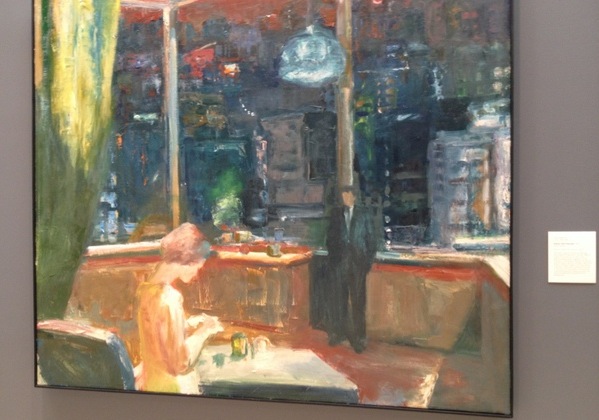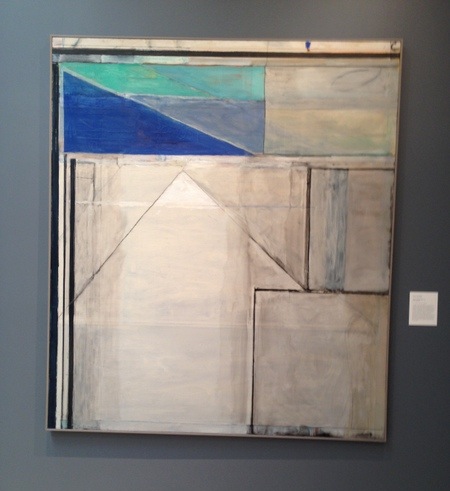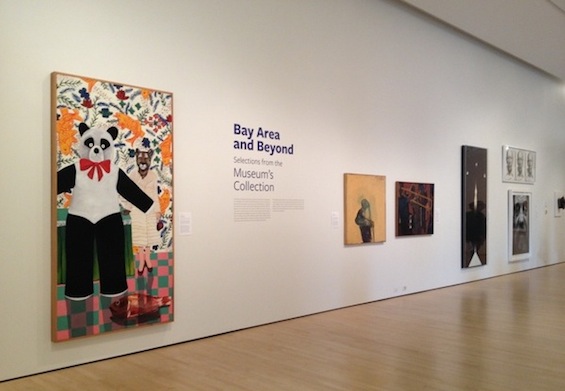The light-filled and spacious Freidenrich Gallery is on the second floor of the Cantor Arts Center at Stanford University. Half of the gallery displays selections from the Cantor’s diverse collection of modern and contemporary art.
Each piece invites me into a different story.
A large canvas, Interior with Cityscape, 1969 by Elmer Bischoff, depicts a woman looking down. In the foreground, she stands next to a desk, in front of a chair. Her hair, skin and clothes are painted in light warm hues like a spotlight. In contrast, a man stands on the far side of the room with his back to a window with a cityscape dominated by high rises. He wears a dark charcoal suit and his hands appear to be in his front pant pockets. His face is featureless. Behind him is a bank of light brown cabinets, waist-high. One light fixture hangs overhead between the woman and man.
The woman and man seem emotionally distant to me. Her head bends as she stares intently at her hands, which are raised to her chest. It isn’t clear if her hands hold anything. The man faces her but seems lost in his own thoughts. What is the story behind their relationship?
A nearby placard says: “The distance between the figures and the interior setting in artificial light recall works by Edward Hopper and Edgar Degas.”
The next canvas, Windows, 1967 strikes me as familiar with its bold chunk of intense blue sky and swath of charcoal jade covering almost a quarter of the canvas’s foreground. A single metal folding chair sits in the bottom right. I guessed the artist correctly: Richard Diebenkorn.
Diebenkorn paints chunky low white buildings beneath a cobalt blue sky and an orange “wall” between most of the dark charcoal jade floor and the buildings. It evokes a sense of the viewer’s importance over the view. Left of the orange wall, we see a building through a dark railing. The placard says this painting pays homage to Henri Matisse and his 1914 painting, Interior with Goldfish Bowl, with “the patterns of the balcony railings and its reference to the artist’s studio with an empty chair.”
For me, Diebenkorn’s painting suggests a feeling of space and light more intense than Matisse’s Interior with Goldfish Bowl. Matisse’s painting seems focused on his thoughts despite looking outward. Dieberkorn’s painting reminded me of the T.S. Eliot quote: “Immature poets imitate, mature poets steal.” Although Diebenkorn didn’t steal, his homage inspired a new work of art with his unique twist.
When I view the abstract painting Ocean Park No. 94, 1976, I’m surprised to learn it is also by Diebenkorn. The different shades and strokes of white and gray set in geometric shapes thinly outlined wash over me like waves. In the upper left corner, a rectangle is divided into two triangles. The lower left triangle is an intense bold blue while the one in the upper right has been horizontally bisected into a light aquamarine blue above a periwinkle blue. I notice a bold thicker black line of paint along the left side of the canvas and along the top of the canvas below a thicker white band.
This superficially simple painting reveals more of its complexity as I take one docent’s advice to look for at least 10 seconds. The giant canvas looks like a jewel set in a crown against the gallery’s dark grey wall. Diebenkorn painted a group of paintings titled, “Ocean Park” when he moved and set up a studio near Santa Monica. I wonder what prompted his move? Because I’ve visited Santa Monica, I can imagine how the blues of the ocean and sky inspired him.
Earlier, I noticed in my peripheral vision a man leaning against a wall. Now, I laugh when I realize he’s a life-like sculpture (Slab Man, 1974-75 by Duane Hanson) “cast in polyester resin from the live model.” He reminded me of an “elderly couple” we met at the Palm Springs Art Museum, also created by Duane Hanson.
The man wears a light colored, short-sleeved worker’s shirt with “Dave” sewn above his right chest pocket. His hairy forearm juts out while his right hand rests on his waist. Work gloves with the word “BOSS” in giant red letters on its cuff protrude from his front pocket along with a long metal tool for smoothing concrete or grout. Dried gritty concrete (maybe?) coats the front of black work boots. His belly strains against shirt buttons. A man observes, “He has a nice watch on.” Slab Man also wears a gold wedding band.
Hanson said: “People enjoy seeing a sort of reflection of their society. The human form is so close to all of us and we don’t really get a chance to analyze it…because of [the] taboos…[of] staring at people….” I circle Slab Man and stare at his bushy eyebrows, unruly thick hair, brown eyes and the way he stands with his right hip slightly out. Others join me as we stare without fear of being rude. What was the story behind how Slab Man became a living model for Hanson?
The next canvas is taller than me and titled, A Family Portrait, 1971 by Joan Brown. A giant panda bear with a red ribbon bow around its neck takes almost half of the canvas. Next to the bear is a gray slate cat face and neck in a pale fur coat with a furry right paw but a human left hand clutching a small burgundy handbag. The “cat” has pale human legs set in burgundy pumps (a hue similar to the purse). At the bottom right is a large red fish on a pink and light teal checkerboard patterned floor. Above the panda and cat are several more light but bright orange fishes.
The placard explains the bear represents Joan Brown’s beloved father while the animal in a fur coat is her “mother, with whom she had a difficult relationship.” The fish on the floor represents the artist, whose astrological sign was Aquarius. Brown’s story of feeling estranged within one’s family of origin is relatable though its permutations differ among families.
While distinct in media and style, each of these pieces, like Hanson said of his Slab Man, provide a portal for the viewer’s reflection, either of self or his or her environment and relationships.
See the museum’s website for more information on the Cantor Arts Center.
Featured photo by Jar (), Creative Commons license via Flickr. “Slab Man” photo by Allie Caulfield, Creative Commons license via Flickr. Post and photos of “Ocean Park No. 94, ” “Interior with Cityscape, ” and “A Family Portrait” by Dolly Lee.
Browse more Literary Tours
Browse more Art Museums & Exhibits
- Regional Tour: The Getty Center in Los Angeles - November 6, 2015
- Regional Tour: A Glimpse of Yosemite - August 14, 2015
- Literary Tour: Mariposa Museum & History Center - May 20, 2015




Maureen Doallas says
You saw work by one of my favorites, Dolly: Diebenkorn. His ‘Ocean Park’ series is justly famous. Terrific painter. One of the last shows at the Corcoran was all Diebenkorn and every part of it was inspiring.
I like the narrative qualities of Bischoff, and ‘Slab Man’ makes me laugh. We have a Hanson, “Woman Eating’, at Smithsonian American Art Museum. Watching people see it for the first time is always delightful.
Thank you for a great tour!
Dolly@Soulstops says
Maureen,
It sounds like it was a fabulous exhibit.
What surprised me was seeing the change in Diebenkorn’s work between the two paintings featured at Cantor. I am much to learn about his work but I felt peaceful as I looked at Diebenkorn’s ‘Ocean Park, No. 94.’
Thanks for coming along for the tour.
jen cleveland says
My son & I went to the Kaneko here in Omaha today to see “Fabric of Survival.” Esther Nisenthal Krinitz, a survivor of the Holocaust sewed these amazing tapestries of her experiences as a child, running for her life with her younger sister. She didn’t start making them till later in life, in order to tell her family about her experiences. It was so gripping, I needed way more time to take it all in.
Dolly@Soulstops says
Jen,
Wow…that really does sound like an exhibit I would have loved to see … I can imagine needing more time to take it all in…What a gift to have been able to see it with your son.
Bethany R. says
Thank you for sharing your experience and insights. I was particularly intrigued by the sculpture and “A Family Portrait.”
Dolly@Soulstops says
Bethany,
Thank you for visiting with me and sharing what intrigued you. What was it about “Slab Man” and “A Family Portrait” that drew you in, if you don’t mind me asking?
Bethany R. says
Thanks for asking, Dolly. I think I was intrigued by those two pieces because they surprised me.
The first few pictures in your piece drew me in. They’re pieces that I’m naturally drawn to and would want to surround myself with at home. Particularly, Ocean Park No. 94. Its chalky textures and nautical color scheme are comforting to me.
The sculpture made me do a double-take. (My kids didn’t believe me when I told them it wasn’t a real person.) I love what you mentioned about it offering the freedom to really look–even stare–at a person. Sculpture, in general offers that opportunity. But this isn’t an emporer, goddess or president. This is particularly fascinating because he looks like someone I’d see at the grocery store: an approachable, modern guy in a short-sleeved button-up and work boots (yes, nice watch).
A Family Portrait was interesting because of what stood out to me after reading the placard’s information. Thanks for sharing that and writing this piece.
Dolly@Soulstops says
Bethany,
Thank you so much for answering my questions. I loved reading your answer. Like you, I did a double take when I saw the “Slab Man”…he looks even more life like in person as the artist, Duane Hanson, actually gave him very realistic hairy arms – that is what struck me as long as his hair and thick eyebrows.
Isn’t it funny how a piece looks different or you notice certain features after reading what a piece meant or might have meant to an artist?
I like the element of surprise and I think you nailed it about those two pieces. Thanks for taking the time to answer my question and bring a smile to my face today 🙂
Bethany R. says
That must have been fascinating to see in-person.
Thanks for the comment back. I enjoyed getting to read your piece. I wouldn’t have “seen” any of these works of art otherwise!
I look forward to more museum posts. 🙂